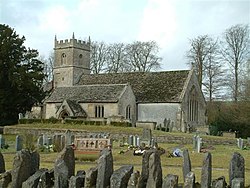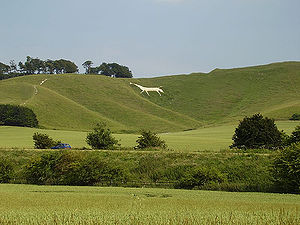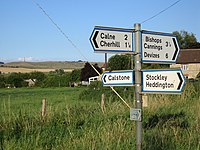Cherhill
| Cherhill | |
| Wiltshire | |
|---|---|
 St James' Church, Cherhill | |
| Location | |
| Grid reference: | SU035702 |
| Location: | 51°25’48"N, 1°56’59"W |
| Data | |
| Population: | 727 (2011) |
| Post town: | Calne |
| Postcode: | SN11 |
| Dialling code: | 01249 |
| Local Government | |
| Council: | Wiltshire |
| Parliamentary constituency: |
North Wiltshire |
| Website: | www.cherhill.org |
Cherhill is a village in Wiltshire, sitting beside the A4 road between Calne and Marlborough, beneath Cherhill Down.
The village grew up on the old coaching road, the Bath Road, now called the A4, which runs from central London to Bristol. Today it has a population of around 700 with a mixture of housing ranging from thatched cottages (some dating to the 14th Century) to newly built detached houses. It has a church, school, pub, village hall and cricket team. The local community spirit is typical of a close-knit village community.
Parish church
Cherhill parish forms part of The Oldbury Benefice together with Compton Bassett, Yatesbury, Heddington and Calstone Wellington.
About the village
Cherhill is known for the Cherhill White Horse cut into the chalk hillside of Cherhill Down in 1780, and for the Landsdowne obelisk also on Cherhill Down. The area around the horse and obelisk is owned by the National Trust.

On a clear day, the 840-foot summit of the Down offers fine views, up to 25 miles, with the water tower at Tetbury in Gloucestershire visible. Atop the tall hill to the north of the village, opposite to Cherhill Downs, it is said to be possible to see the two Severn crossings, the Severn Bridge and Second Severn Crossing, 38 miles to the west.

At one of the village's bus shelters is a millennium project of a sundial. Consisting of a vertical sarsen stone inside a face of Roman numerals, it symbolizes the passage of time.
History
John Marius Wilson's Imperial Gazetteer of England and Wales (1870-1872) says of Cherhill:[1]
| “ | CHERHILL, a parish in Calne district, Wilts; near Wans Dyke, 2½ miles E by S of Calne r. station, and 7 NNE of Devizes. It has a post office under Chippenham. Acres, 1, 817. Real property, £2, 574. Pop., 364. Houses, 88. The property is all in one estate. An ancient square camp with double works, called Oldbury, is on the summit of a chalk hill; and the figure of a horse, 157 feet long, cut out of the turf about 1780, and visible for many miles, is on the side of the same hill. The living is a rectory in the diocese of Salisbury. Value, £300. Patron, the Bishop of Salisbury. The church is old but very good; and there is a Primitive Methodist chapel. | ” |
In 1845 the Third Marquess of Lansdowne erected the Lansdowne Monument, or Cherhill Monument, a 125-foot stone obelisk, in honour of his ancestor Sir William Petty.
Cherhill White Horse and Oldbury Hill Fort
The Cherhill White horse was cut out of the hillside in 1780. It has been restored several times due to chalk being washed away and weeds growing on it. The horse is visible from miles around and has become a landmark synonymous with the village and local area. The most recent restoration to the delicate chalk carving took place in 2006.
In 2005, the horse was covered in black stripes to give it more of an exotic appearance; the owners of a local car franchise were attempting to make it appear more like a Panda (although it more closely resembled a Zebra), as a publicity stunt to help launch a new vehicle of the same name.
The top of the National Trust owned Cherhill Down is home to the neolithic settlement, Oldbury Hill Fort. From here it is possible to see the route of an ancient Roman road heading toward the nearby Wansdyke trade route. The top of the hill is popular with ramblers, dog walkers and power kiters, owing to the powerful winds in action.
The Cherhill Gang
The Cherhill Gang was a notorious group of highway men who operated in the 18th century on the London to Bath main road which passes through the village — they were noted for their robbery technique of attacking the carriages of rich Londoners while completely naked, thus shocking passengers into handing over their money and also making it harder to identify them. A painting depicting one such attack can be seen in the Black Horse pub, on the A4 main road in the village.

Outside links
| ("Wikimedia Commons" has material about Cherhill) |
References
- ↑ Descriptive Gazetteer entry for CHERHILL at visionofbritain.org.uk, accessed 20 July 2008
Books
- Plenderleath, Rev. W. C.:
- On the White Horses of Wiltshire and Its Neighbourhood (Wilts Archaeological Magazine, vol. 14 for the year 1872, pp. 12-30)
- White Horses of the West of England (London, Allen & Storr, 1892)
- Plenderleath's Memoranda of Cherhill (2001)
